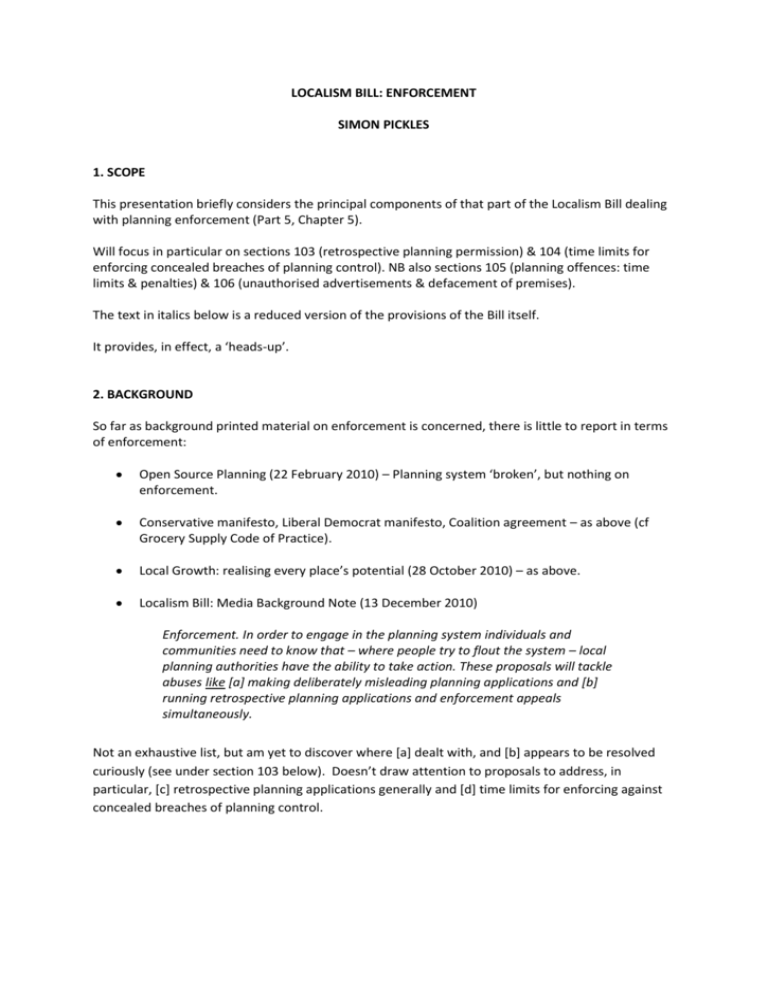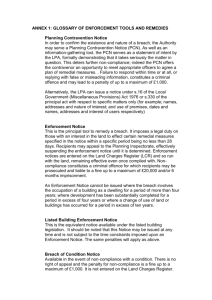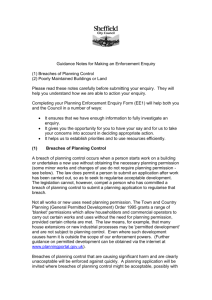LOCALISM BILL: ENFORCEMENT SIMON PICKLES 1. SCOPE This
advertisement

LOCALISM BILL: ENFORCEMENT SIMON PICKLES 1. SCOPE This presentation briefly considers the principal components of that part of the Localism Bill dealing with planning enforcement (Part 5, Chapter 5). Will focus in particular on sections 103 (retrospective planning permission) & 104 (time limits for enforcing concealed breaches of planning control). NB also sections 105 (planning offences: time limits & penalties) & 106 (unauthorised advertisements & defacement of premises). The text in italics below is a reduced version of the provisions of the Bill itself. It provides, in effect, a ‘heads-up’. 2. BACKGROUND So far as background printed material on enforcement is concerned, there is little to report in terms of enforcement: Open Source Planning (22 February 2010) – Planning system ‘broken’, but nothing on enforcement. Conservative manifesto, Liberal Democrat manifesto, Coalition agreement – as above (cf Grocery Supply Code of Practice). Local Growth: realising every place’s potential (28 October 2010) – as above. Localism Bill: Media Background Note (13 December 2010) Enforcement. In order to engage in the planning system individuals and communities need to know that – where people try to flout the system – local planning authorities have the ability to take action. These proposals will tackle abuses like [a] making deliberately misleading planning applications and [b] running retrospective planning applications and enforcement appeals simultaneously. Not an exhaustive list, but am yet to discover where [a] dealt with, and [b] appears to be resolved curiously (see under section 103 below). Doesn’t draw attention to proposals to address, in particular, [c] retrospective planning applications generally and [d] time limits for enforcing against concealed breaches of planning control. 3. RETROSPECTIVE PLANNING PERMISSION (section 103) 3A. Generally A local planning authority [LPA] in England may decline to determine an application for planning permission [pp] for the development of any land if granting pp would involve granting, whether in relation to the whole or any part of the land to which an enforcement notice [EN] relates, pp in respect of the whole or any part of the matters specified in the EN as constituting a breach of planning control. The power to decline applies across the board and without time limit, where an enforcement notice is in place (albeit in England only) - though media/political discussion of imposing limits on retrospective planning applications has focussed on gypsies & travellers (Among proposals believed to be under discussion - and due to be unveiled in the Autumn - EP, the CLG minister, is considering increasing local say in planning decisions as well as halting retrospective planning permission for gypsies and travellers: BBC News 25 August 2010). There is no means of testing a decision to decline on its merits. An application for JR provides a blunt check on the exercise of this power – particularly where there are no statutory criteria for its exercise (though there would no doubt be circular advice). The fact that little use appears to be made of the current powers to decline does not itself justify their extension in circumstances where the potential clearly exists for unfairness. There exists, in any case, an alternative course of action: an LPA may refuse pp, and may be awarded costs in the event of a wholly unmeritorious appeal against that refusal. It is not objectionable in principle that a landowner or occupier should seek to test the ‘continuing expediency’ of an EN on its merits – and it certainly appears that he should be able to do so, subject to the discipline of the costs regime. 3B. Running retrospective planning applications and enforcement appeals simultaneously An appeal may not be brought on the ground [that pp should be granted or a condition or limitation be discharged] if (a) the land to which the EN relates is in England, and (b) the EN was issued at a time (i) after the making of a related application for pp, but (ii) before the end of the period [for appeal against deemed refusal] in the case of that application. An application for pp is related to an EN if granting pp would involve granting pp in respect of the matters specified in the EN as constituting a breach of planning control. A curious provision, this (limited to England, again). Unclear that any very substantial mischief is being addressed, ie running an enforcement notice appeal and retrospective planning application in parallel. Parallel appeals don’t in practice appears to raise any significant administrative issues. And there may be sensible reasons for parallel appeals – the allegation (and therefore deemed planning application) may not be fit for purpose in all respects, or it may simply be sensible to give the Inspector a further choice. Unclear also why it is the EN, and not the planning, appeal that is stopped in its tracks. 4. TIME LIMITS FOR ENFORCING CONCEALED BREACHES OF PLANNING CONTROL (section 104) 4A. General Section 104 introduces three new sections into TCPA as follows: 171BA Time limits in cases involving concealment 171BB Planning enforcement orders: procedure 171BC Making a planning enforcement order Obscure draughtsmanship informs the reader of the outcome of the “new planning enforcement order *PEO+” procedure (the ability to take enforcement action within prescribed time limits) before telling him how a PEO may be applied for and secured, and – fundamentally – in what circumstances he may expect to secure one. This appears to be all the wrong way around. I have therefore unscrambled the provisions for ease of presentation, though there is a serious and broader point to be made about the complexity of the provisions within this part of the Bill. 4B. Applying for a PEO Where it appears to the LPA that there may have been a breach of planning control in respect of any land in England, the authority may apply to a magistrates’ court [MC] for a PEO in relation to that apparent breach. An application for a PEO may be made within the 6 months beginning with the date on which evidence of the apparent breach sufficient in the opinion of the LPA to justify the application came to its knowledge. A certificate (a) signed on behalf of the LPA and (b) stating the date on which evidence sufficient in the authority’s opinion to justify the application came to its knowledge is conclusive evidence of that fact; and a certificate stating that matter and purporting to be so signed is to be deemed to be so signed unless the contrary is proved. There is no general time limit: a PEO may be applied for at any time following substantial completion of development. Availability of power triggered by the appearance that there may have been a breach of planning control. Availability limited to 6 months from point in time at which LPA considers it has sufficient information to justify an application. The uncertainties recognised to be implicit in this formula (whose knowledge matters? what’s sufficient and justifies an application?) to be resolved by handy selfcertification. 4C. Granting a PEO A MC may make a PEO in relation to an apparent breach of planning control only if: (a) the court is satisfied, on the balance of probabilities, that the actions of a person or persons have resulted in, or contributed to, full or partial concealment of the apparent breach or any of the matters constituting it (a person’s actions are to be taken to include representations made by the person and inaction on his part); and (b) the court considers it just to make the order having regard to all the circumstances. PEO may be made where concealment has occurred. No definition within the Bill (‘the action of concealing or keeping secret; the action of hiding or concealing anything from view’ (Shorter OED)). Current formulation leaves many issues unresolved: whether concealment may be innocent or deliberate; whether partial concealment may expose the entirety of a breach to enforcement; and whose concealment matters. The remarkable, generalised invocation of justice is an implicit recognition of the potential for injustice arising from these provisions (NB the breach of planning control buried at the end of the garden). 4D. Effect of a PEO If a MC makes a PEO in relation to an apparent breach of planning control, the LPA may take enforcement action in respect of the apparent breach or any of the matters constituting it at any time in the enforcement year, ie the year that begins at the end of 22 days beginning with the day on which the order is given (subject to an application for statement of case). This (a) applies whether or not the time limits under section 171B have expired and (b) does not prevent the taking of enforcement action after the end of the enforcement year but within those time limits. A PEO makes available any of the enforcement options under TCPA Part VII for a period of one year. Quaere: why a further 12 months provided following the hearing in the MC – but, then again, not 4 or 10 years. (a) confirms the absence of a time limit on PEOs, whilst (b) appears to reflect an abundance of caution. 4E. PEO procedure Where the LPA apply to a magistrates’ court for a PEO in relation to an apparent breach of planning control, the authority must serve a copy of the application on (a) the owner and occupier of the land and (b) on any other person having an interest in the land that is an interest which, in the authority’s opinion, would be materially affected by the taking of enforcement action. The persons entitled to appear before the court include (a) the applicant,(b) any person on whom a copy of the application was served by the authority, and (c) any other person having an interest in the land that is an interest which, in the opinion of the court, would be materially affected by the taking of enforcement action. MC has power to hear from others. 4F. PEO postscript In determining whether the time for taking enforcement action in respect of a matter has expired within TCPA section 191, that time is to be taken not to have expired if (a) the time for applying for a PEO in relation to the matter has not expired, (b) an application has been made for a PEO and the application has neither been decided nor been withdrawn, or (c) a PEO has been made, the order has not been rescinded and the enforcement year for the order (whether or not it has begun) has not expired. Self-certification will displace the lawfulness of operational development and land uses pending enforcement or expiry of the enforcement year. 5. AN OVERVIEW Highly questionable whether exclusion of retrospective planning applications where EN in place a balanced response to the issue that can arise. Exclusion of simultaneous retrospective planning applications and enforcement appeals curious. The concealed breaches provisions have potential to introduce very considerable uncertainty. Whatever the professional/legal misgivings may be, it must be anticipated that there is, in these particular respects, to be a re-settlement of enforcement powers. This seminar paper is made available for educational purposes only. The views expressed in it are those of the author. The contents of this paper do not constitute legal advice and should not be relied on as such advice. The author and Landmark Chambers accept no responsibility for the continuing accuracy of the contents.





